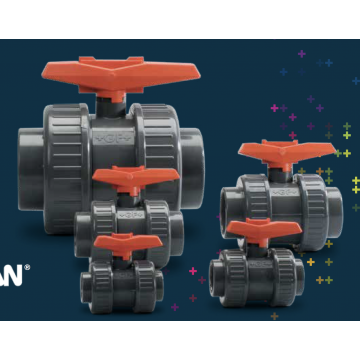Ball Valve
Type 375 ChlorFIT True Union Ball Valve
The Type 375 Ball Valve shall be true union and utilize a floating ball design. The ball shall be full port with two-way block-ing capability. The stem shall be blowout proof and utilize a double o-ring seal. The seat carrier shall be adjustable with the handle doubling as a seat carrier adjustment or removal tool. Ball seats shall have an elastomeric backing o-ring and all elastomeric seals shall be of like material. ANSI flanged versions shall meet the ANSI B16.5 150lb standard. All valves shall be tested in accordance with ISO9393 and designed to ISO16135 standards. All valves shall be manufactured under ISO9001 for Quality and ISO14001 for Environmental Management. PVC valves shall meet ASTM D1784 cell classification 12454 standards. CPVC valves shall meet ASTM D1784 cell classification 23447 standards. PPn valves shall meet ASTM D4101 standards. Valves of all materials shall be RoHS compliant.
General:
• Size: ⅜”–4”
• Material: PVC, CORZAN® CPVC, or PPn
• Seat: PTFE
• Seals: EPDM or FPM
• End Connection: Solvent cement socket, threaded, flanged, PPro-Seal™ electrofusion socket
• Standard Pack Quantity: 1 valve
Optional Features:
Vented Ball: For sodium hypochlorite use
Key Certifications:
• NSF 61: PVC and CPVC
• USP Class VI (physiological non-toxic): EPDM, FDM, PTFE, PP
• FDA CFR 21 177.1520: PPn
• CORZAN: CPVC
Key Design Features:
An arrow is molded on the body of the Type 375 to indicate the side of the valve with a fixed seat. The valve is bidirectional, so the installation direction does not affect the valve’s performance. However, the installation direction of the fixed side of the valve does provide benefits for both upstream and down-stream installs. When a valve is closed, the ball seal in a pressurized system is provided by the downstream seat, it is, therefore, advantageous to install the valve with the fixed side downstream. Depending on system design, it can be easier to adjust the seat carrier of a valve if the fixed seat is upstream because the upstream side of the valve does not need to be depressurized.
Vented Ball: Optional Feature
A vented ball is an optional feature with all variations of the Type 375 Ball Valve. This version of the valve has dedicated part numbers that utilize a special ball with a ⅛ inch hole. This ball is designed for applications in which the media requires out-gassing such as sodium hypochlorite. The hole functions as a vent for media that would normally be trapped inside a closed ball. The vent prevents potentially dangerous pressure from building up inside the valve. The vent is located on the seat carrier side of the ball valve and this side is recommended to be installed upstream. Chemical applications vary from system to system and variations such as concentration, temperature and pressure need to be considered. It is the responsibility of the individual user to verify compatibility and GF recommends that every application be verified and tested by internal experts or a third party.
—



